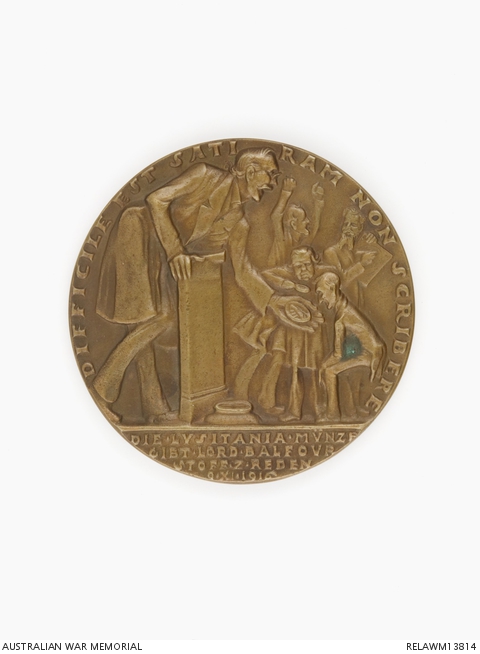| Place | Europe: Germany |
|---|---|
| Accession Number | RELAWM13814 |
| Collection type | Heraldry |
| Object type | Medallion |
| Physical description | Bronze |
| Maker |
Goetz, Karl |
| Place made | Germany |
| Date made | c 1916-1917 |
| Conflict |
First World War, 1914-1918 |
German satirical medallion 'Difficile est Satiram non Scribere'




The medallion obverse depicts, in high relief, Lord Balfour (British First Lord of the Admiralty) showing a controversial Lusitania Medallion to onlookers. Above them is the text 'DIFFICILE EST SATIRAM [sic] NON SCRIBERE'. Beneath is the text 'DIE LUSITANIA MVNZE GIBT LORD BALFOVR STOFF Z REDEN 9 XI 1916' (The Lusitania Medal gives Lord Balfour much to talk about 9 November 1916). The reverse depicts, in high relief, a Scotsman (England) playing bagpipes and carrying a large poster referring to the Lusitania Medallion '...FLUG BLATT EIN DEVTSCHER SEE SIEG 1916' (...leaflet a German sea victory Lusitania Medal 1916). Around the edge are the words: 'ENGLISCHE HETZ ARBEIT IN SCHWEDEN' (English agitation work in Sweden).
This medallion was designed and made by Karl Goetz in response to the British indignation over an earlier medallion he had produced in 1916 about the sinking of the SS Lusitania on 7 May 1915. It makes specific reference to a speech given by Arthur Balfour, the British First Lord of the Admiralty on 9 November 1916. In the speech Balfour denounced the German Navy and made reference to Goetz's Lusitania Medallion.
The original Lusitania Medallion was privately designed and struck by Karl Goetz in August 1915 to mark the sinking, by a German U-boat, of the Cunard liner Lusitania in 1915. The sinking of the Lusitania was a controversial event and became a focus for the propaganda campaign during the war.
The Lusitania was sunk by a torpedo fired from a German U-boat on 7 May 1915 near Ireland. Most of the passengers were drowned. The log of the U-boat stated only one torpedo had been fired at the Lusitania, however a second explosion led people to believe that two were fired. The speed with which the ship sank (it took only 18 minutes), and the second explosion, later led to rumours that high explosives were secretly carried on board the Lusitania.
Germany claimed the Lusitania was a legitimate target, due to being a British Armed Merchant Carrier (she was listed as one, but had not been fully fitted out as one), her cargo of war materiel, and she was sunk within the British war zone. However there was uproar in the British and American press, focusing on the loss of civilian life. Goetz's medallion was produced in response to this, to illustrate the hypocrisy of the British Government, who he felt had tried to use the passengers as human shields to assist in moving contraband (such as the explosives rumoured to have been aboard), despite the warnings of the German Government.
The medallion was produced privately by Goetz in a small run, and sold in Munich and to some numismatic dealers. Unfortunately for Goetz, there was an error on his medallion. He mistakenly recorded the date of the sinking as 5 May - two days before the event actually took place. He later blamed this error on a newspaper report he read.
One of the medallions made its way to England, where its content caused outrage. The error about the date led to the perfect propaganda tool for the British, who claimed that it showed the sinking of the Lusitania was premeditated. Although the medallion was privately produced, the press claimed it was endorsed by the German Government, had been awarded to the crew of the attacking U-boat, and distributed throughout Germany.
In Britain, the production of a copy, with the original German 'MAI' spelt 'MAY' was authorised (although due to the quality of the work, some of the British examples appear to also read 'MAI'), with the funds raised to go to charity. The production run of approximately 300,000 in various metals (most in die cast iron) was undertaken by department store owner Gordon Selfridge. They were offered to the public at prices starting at one shilling each, to raise funds for charity. The medallions were contained in a presentation box and were accompanied by a leaflet, describing the cruelty of the Germans, who killed innocent women and children. This reinforced the stereotype of the bestial German Hun which had become prevalent in British propaganda.
Due to the controversy surrounding his medallion and the incorrect date, Goetz made a second run of the medallion, with the correct date of 7 May. However, the damage had already been done. Despite the controversy, and the trouble he was in with the German Government, Goetz continued to defend his medallion as satire, as illustrated in the creation of this second medallion.